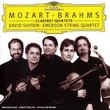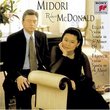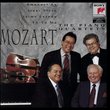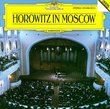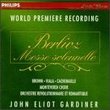| All Artists: Robert Schumann, Leonard Bernstein, Weiner Philharmoniker Title: Schumann Symphonies 1 Spring & 4 Op.120 Members Wishing: 0 Total Copies: 0 Label: Polygram Records Release Date: 10/25/1990 Genre: Classical Style: Symphonies Number of Discs: 1 SwapaCD Credits: 1 UPC: 028941527424 |
Search - Robert Schumann, Leonard Bernstein, Weiner Philharmoniker :: Schumann Symphonies 1 Spring & 4 Op.120
 | Robert Schumann, Leonard Bernstein, Weiner Philharmoniker Schumann Symphonies 1 Spring & 4 Op.120 Genre: Classical |
CD DetailsSimilarly Requested CDs |
CD ReviewsA Couplet to the Spring Robin Friedman | Washington, D.C. United States | 03/31/2007 (5 out of 5 stars) "In his long comic poem, "The Comedian as the Letter C" the American poet Wallace Stevens tells of the wanderings of a character named Crispin. Crispin wants to live in the world of romance and imagination, but he is too taken with the everyday world of cold factuality. Nevertheless, Stevens describes him, with an ambivalent affection, as "he/that wrote his couplet yearly to the spring."
Spring brings out the voice of true romanticism. No matter how old you are or what experiences you have had, Spring can be the season of hope, love, rebirth, and regeneration, spiritual and sexual. All these are celebrated in Schumann's first symphony, the "Spring". It is performed on this CD by another musical romantic, Leonard Bernstein, conducting the Vienna Philharmonic. With his passion, idiosyncracy, and freeness, Bernstein was the ideal conductor of Schumann. It shows here. Bernstein's entire cycle of the four Schumann symphonies is readily available on DG in a 2-CD set at a low price. But I wanted to concentrate on Schumann's Spring, and so I am reviewing only this CD, consisting of the first and fourth symphonies, to remind myself of the poetry of springtime and its message of hope. Schumann composed his Spring Symphony in B-flat major, opus 38 in 1841 in a matter of weeks. It is a tribute to his love for his hard-won wife, Clara, and to the spirit of renewal. Schumann too had his poet, and his symphony was inspired by a poem about spring by his contemporary, one Adolph Bottger. Schumann was going to give each of the four movements in the work a programmatic title, but abandoned the idea. In its lyricism, joy, and poetry, this symphony is the work not of a Beethoven but of a Schumann coming to himself and eager to give voice to an intimate poetry within the boundaries of the symphony. The work opens with a lovely fanfare for brass introducing the coming of the season. It is followed by a lively first movement with many special touches. My favorite is the new singing theme just before the end. The slow second movement is based upon a long, languid theme, while the third movement is full of energy. The finale is based upon a simple theme which music scholar Donald Francis Tovey described as "slight as a daisy-chain." I found listening to this symphony an inspiring way of trying to prepare myself for the new season. Schuman composed his fourth symphony in d-minor opus 120 late in 1841 but he revised it in 1853. This latter version is almost always the one performed. It shares the romanticism of Schumann's spring symphony, but it is at the same time, more serious, wayward. and tumultuous. For some listeners, the fourth also shows Schumann's difficulties with orchestration, but I find this deficiency in the composer substantially exaggerated. The work is in four movements with interrelating themes connecting the first and fourth movements and the second and third. The work exhibits a wide and fluctuating emotional range -- as does Schumann's own life. The opening of both the first and final movements is somber austure and tragic. But with magical use of the trombones and brass, Schumann lifts both movements to triumphant, heroic conclusions. The second movement opens with a reflective theme for cello alone, which is soon replaced by a more lyrical passage which comes to the fore again in the midst of the scherzo. The fourth symphony too celebrates the spirit of musical romanticism in its turbulent, unfocused emotion. Furtwangler's reading is probably the standard for Schumann's fourth, but Bernstein here, with his heart-on- his- sleeve approach comes close. Romaticism is a difficult attitude for people today. It is hard for me, and it was hard as well for Wallace Stevens and for his Crispin. I was fortunate to have to hand the voice of true, unabashed, unapologetic romanticism in the Spring symphony of Schumann and the interpretation of Bernstein. Robin Friedman" |

